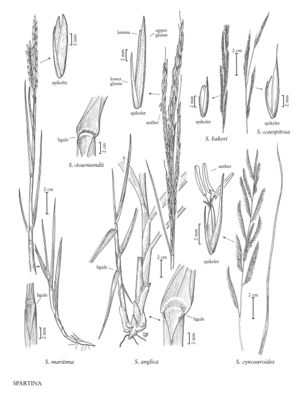Spartina ×townsendii
Plants rhizomatous; rhizomes whitish, scales not inflated, not closely imbricate. Culms to 150 cm, relatively hard, solitary or in small clumps. Sheaths mostly glabrous, throats pilose, lower sheaths often wrinkled; ligules 1-1.8 mm; blades 6-30 cm long, 4-12 mm wide, diverging 20-45° from the culms, flat proximally, involute distally, both surfaces glabrous, margins smooth. Panicles 15-25 cm, with 2-10 branches; branches 4-24 cm, loosely appressed, with 10-30 spikelets. Spikelets 16-22 mm. Glumes mostly appressed pubescent, margins glabrous or sparingly hispidulous; lower glumes 8-14 mm, linear, acuminate to obtuse; upper glumes 16-22 mm, acuminate to obtuse; lemmas mostly pubescent, keels glabrous near the base, margins glabrous throughout, apices obtuse to rounded or obscurely lobed; anthers 5-10 mm, poorly filled, indehiscent at maturity. 2n = 60, 60+2.
Discussion
Spartina ×townsendii is a sterile hybrid between the European S. maritima and the American S. alterniflora. It seems to have formed spontaneously at several locations in Europe, often taking over the areas formerly occupied by its progenitors. At some locations it has given rise to the fertile amphiploid S. anglica, from which it differes morphologically in its narrower, less divergent upper blades, shorter ligules, shorter, less hairy spikelets, and poorly filled, indehiscent anthers. Spartina ×townsendii has been used throughout the world for tideland reclamation because it is easy to establish, but it displaces native species.
Selected References
None.
